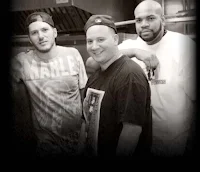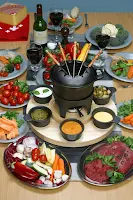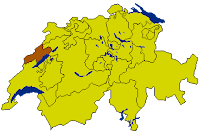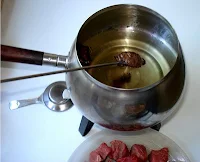 Did you ever wonder how and why certain foods became classified as edible? For instance, who was it that first decided they would try milking a cow after watching a newborn calf suckle, reaching under, squeezing out a bit of milk from an udder and then deciding to taste it? Now that's a 'foodie!' We have many brave pioneers to thank for paving the way for the plethora of culinary excursions and delights we now enjoy.
Did you ever wonder how and why certain foods became classified as edible? For instance, who was it that first decided they would try milking a cow after watching a newborn calf suckle, reaching under, squeezing out a bit of milk from an udder and then deciding to taste it? Now that's a 'foodie!' We have many brave pioneers to thank for paving the way for the plethora of culinary excursions and delights we now enjoy. Well, I've always wondered the same about mushrooms. After all, it is a fungus, usually found growing on or under tree roots. And, only certain ones are edible, with some psilocybic types, or 'Shrooms,' sending anyone who eats them on a psychedelic trip into mind numbing hallucinations. It has long been held that
 Alice's trip through the looking glass started with a mushroom. "Go ask Alice....when she's ten feet tall."
Alice's trip through the looking glass started with a mushroom. "Go ask Alice....when she's ten feet tall."Yet others are so toxic and deadly, they can kill you with just one nibble. How did they find the edible ones? For instance, back in Egypt, who drew the short straw when, upon finding this little darling growing on a tree stump, they all looked at each other and said, "Who, me? No way! Pharaoh schmaroh, I'm not putting that in my mouth!" Did they try them on 'subjects?' Was there a checklist, so that when Harry, the tester, dropped dead after eating this new variety brought in from the forest, we documented it? Talk about a position with no job security.
Whatever the reason for trying them, thank God someone had the courage to eat these little beauties, transforming them into the well loved staple of stews, soups, and the now many and diverse applications, from liqueurs to dusts, that we all enjoy today.
 What I found amazing in my research was that, most people think of a mushroom as the fungi, when it actuality it is the 'fruit' of the fungi. The mycelium , the main body, is subterranean, or lives on dead trees and living tree roots and it can vary in size from a few inches to several miles wide! When they absorb a large amount of water, they can grow amazingly fast and their fruits sprout out of the ground overnight. Have you ever woken up, gone to get the paper and gazed out at your front lawn after a good soaking rain only to be confronted with an invasion of mushrooms that have miraculously appeared overnight? Well, they were there all along! You can put that mystery to bed...I know it's been bugging you....Now you know.
What I found amazing in my research was that, most people think of a mushroom as the fungi, when it actuality it is the 'fruit' of the fungi. The mycelium , the main body, is subterranean, or lives on dead trees and living tree roots and it can vary in size from a few inches to several miles wide! When they absorb a large amount of water, they can grow amazingly fast and their fruits sprout out of the ground overnight. Have you ever woken up, gone to get the paper and gazed out at your front lawn after a good soaking rain only to be confronted with an invasion of mushrooms that have miraculously appeared overnight? Well, they were there all along! You can put that mystery to bed...I know it's been bugging you....Now you know.These little fruits, mushrooms, are the delicacies that we humans enjoy. There are over two thousand types of mushrooms, but only 2 ½ - 5 % are edible. The rest are highly poisonous and can masquerade as the edible ones, which is why if you are going to try your hand at foraging for wild mushrooms, make sure you do it with someone who is qualified in distinguishing the real deal from the pretenders. It's a risky and sometimes fatal
 |
| Amanitas |
Some 'shrooms' contain enough toxins to immediately kill the person who eats them, like the Amanitas strain. Historical records reveal that Claudius II and Pope Clement VII were both killed by enemies who poisoned them with this deadly variety. Buddha died, according to legend, from a mushroom that grew underground. Buddha was given the mushroom by a peasant who believed it to be a delicacy.
Mushroom Facts
- Mycophagy is the act of consuming mushrooms and dates to ancient times.
- Mushrooms have been an essential in Chinese medicine for centuries, containing vitamins B, C and D. They are known to lower both blood pressure and serum cholesterol.
- City of Hope, a cancer research facility, has suggested that mushrooms may help prevent cancer.
- The living body of the fungus is a mycelium made out of a web of tiny filaments called hyphae. The mycelium is usually hidden in the soil, in wood, or another food source.
- A mycelium may be small enough to fill a single ant or large enough to cover many acres.
- The branching hyphae can add over a half mile (1 kilometer) of total length to the mycelium each day!
- These webs live unseen until they develop mushrooms, puffballs, truffles, brackets, cups, “bird’s nests,” “corals” or other fruiting bodies.
- Mushrooms grow from spores, not seeds, and a single mature mushroom will drop as many as 16 billion spores!
 Some of the oldest living mushroom colonies are fairy rings ---> growing around the famous Stonehenge ruins in England. The rings are so large that the best view of them is from a plane.
Some of the oldest living mushroom colonies are fairy rings ---> growing around the famous Stonehenge ruins in England. The rings are so large that the best view of them is from a plane.
 |
| Dancing Shaman. |
In the winter of 1991, hikers in the Italian Alps came across the well preserved
 remains of a man who died over 5,300 years ago, approximately 200 years later than the Tassili cave artist. Dubbed the "Iceman" by the news media, he was well equipped with a knapsack, flint axe, a string of dried Birch Polypores (Piptoporus betulinus) and another yet unidentified mushroom. The polypores can be used as tinder for starting fires and as medicine for treating wounds. Further, a rich tea with immuno-enhancing properties can be prepared by boiling these mushrooms. Equipped for traversing the wilderness, this intrepid adventurer had discovered the value of the noble polypores. Even today, this knowledge can be life-saving for anyone astray in the wilderness.
remains of a man who died over 5,300 years ago, approximately 200 years later than the Tassili cave artist. Dubbed the "Iceman" by the news media, he was well equipped with a knapsack, flint axe, a string of dried Birch Polypores (Piptoporus betulinus) and another yet unidentified mushroom. The polypores can be used as tinder for starting fires and as medicine for treating wounds. Further, a rich tea with immuno-enhancing properties can be prepared by boiling these mushrooms. Equipped for traversing the wilderness, this intrepid adventurer had discovered the value of the noble polypores. Even today, this knowledge can be life-saving for anyone astray in the wilderness.Mushrooms, the plant of immortality? That’s what ancient Egyptians believed according to the Hieroglyphics of 4600 years ago. The delicious flavor of mushrooms intrigued the pharaohs of Egypt so much that they decreed that mushrooms were food for royalty and that no commoner could ever touch them. This assured themselves the entire supply of mushrooms. In various other civilizations throughout the world including Russia, China, Greece, Mexico and Latin America, mushroom rituals were practiced. Many believed that mushrooms had properties that could produce super-human strength, help in finding lost objects and lead the soul to the realm of the gods.
Mushroom Varieties
 Black Trumpet
Black TrumpetColor can vary from purply-gray to death-like black. Lily shaped, thin flesh, delicate taste. Available fresh fall through spring.

Button
Bland taste compared to other mushrooms. Available fresh year round.

Cepe/Porcini
Also called Polish, Porcini or King Bolete. Bulbous stem with brown, rounded cap. Rich, musty flavor and very perishable. Available fresh in fall, dried and frozen year round.
C
 hanterelle
hanterelleCurved trumpet or vase shape, color varies from bright orange to apricot gold. Some say it imparts the smell of apricots. Available fresh during fall and winter, dried year round.
 Cremini
CreminiCremini, Button and Portabellas are related. Cremini looks like a button, but is a bit larger with a brown cap. When growth is unchecked, it becomes a Portabella with more complex flavor and texture.

Enoki
Dainty, Q-Tip shaped. Cultivated and available fresh year round.
Hedgehog
Squash colored and slightly bitter tasting. Substitute for Chanterelles. Trim stems. Hedgehogs have small “teeth” on gills and break off in other foods, leaving gold flecks.
Matsutake
Also called Pine mushroom. Spicy, woody flavor. Available fresh in fall.

Morel
Spongy looking but hollow. Color is tan to dark brown. Intense, earthy flavor. Available fresh in spring, dried year round.
Oyster
Cultivated, fan-shaped. Color varies from light tan to gray. Mild flavor. Available fresh year round.
 Shitake
ShitakeAlso called Chinese, Black Forest or Oak mushrooms. Chocolate brown, fibrous, woody stems. Available fresh and dried year round.

Wood-ear
Rubbery texture, flat, woodsy aroma. Imported from China. Available dried year round.

Yellowfoot
Fragrant member of Chanterelle family. Gray-brown color with muted gold stem. High water content.
Earth's Largest living Organism...The Honey Mushroom
 People have known about the "honey mushroom" for some time, but were not aware of how large and invasive this species of fungus could be. The fungus was investigated more closely by researchers when they realized that it was responsible for killing large groves of evergreen trees. When foresters cut into an infected tree they would find spreading white filaments, mycelia, which draw water and carbohydrates from the tree to feed the fungus.
People have known about the "honey mushroom" for some time, but were not aware of how large and invasive this species of fungus could be. The fungus was investigated more closely by researchers when they realized that it was responsible for killing large groves of evergreen trees. When foresters cut into an infected tree they would find spreading white filaments, mycelia, which draw water and carbohydrates from the tree to feed the fungus. Researchers collected samples of the fungus from a widespread area and analyzed the DNA. A large sample of the specimens they collected turned out to be from a single organism. Until August of 2000 it was thought that the largest living organism was a fungus of the same species (Armillaria ostoyae) that covered 1,500 acres
 (600 hectares) found living in the state of Washington.
(600 hectares) found living in the state of Washington.Mycology experts surmised that if an Armillaria that large could be found in Washington, then perhaps one just as large could be responsible for the trees dying in the Malheur National Forest in the Blue Mountains of eastern Oregon. Researchers were astonished at the sheer magnitude of the find. This most recent find was estimated to cover over 2,200 acres (890 hectares) and be at least 2,400 years old, possibly older.
 To go into the forest where this giant makes its home you would not look at it and see a huge, looming mushroom. Armillaria grows and spreads primarily underground and the sheer bulk of this organism lies in the earth, out of sight. Occasionally, during the fall season, this specimen will send up golden-colored "honey mushrooms" that are the visible evidence of its hulking mass beneath. Scientists have not yet begun to attempt to estimate the weight of this specimen of Armillaria.
To go into the forest where this giant makes its home you would not look at it and see a huge, looming mushroom. Armillaria grows and spreads primarily underground and the sheer bulk of this organism lies in the earth, out of sight. Occasionally, during the fall season, this specimen will send up golden-colored "honey mushrooms" that are the visible evidence of its hulking mass beneath. Scientists have not yet begun to attempt to estimate the weight of this specimen of Armillaria.Well there you have it, mushrooms in all their glorious forms. Hope you enjoyed it. After all. what's a little fungus among friends,?
Bon Appetit,
Sources: www.stayinpiedmont.com, www.chekyang.com, www.wikipedia.org, www.edupic.net,www.lifeinitaly.com, www.ehow.com, www.mushroom-appreciation.com, www.lemdell.com.au, www.groundtruthtrekking.org, www.foodists.ca,www.foodsnherbs.com, www.naturesbounty.com, http://tinyurl.com/c646hnd




























